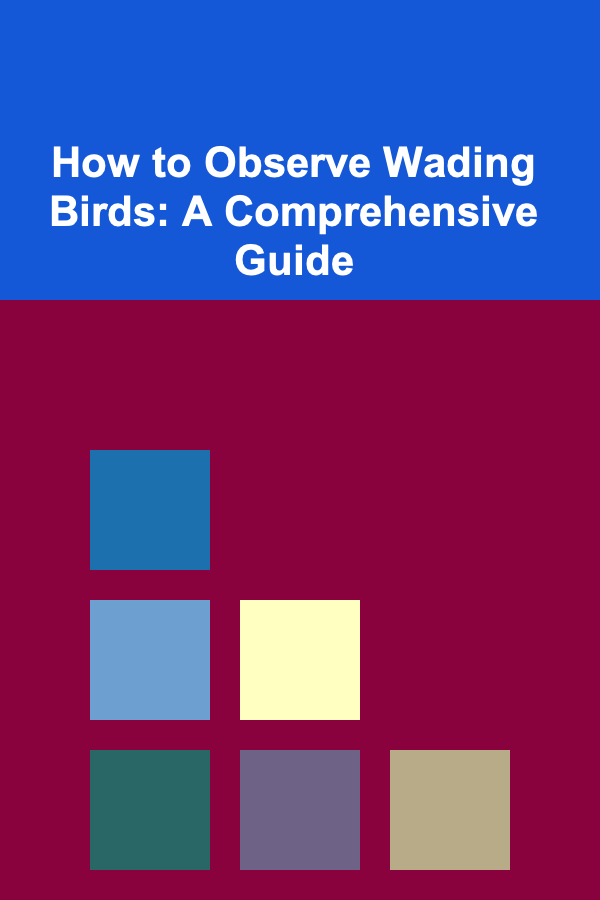
How to Observe Wading Birds: A Comprehensive Guide
ebook include PDF & Audio bundle (Micro Guide)
$12.99$11.99
Limited Time Offer! Order within the next:

Wading birds, with their elegant forms and fascinating behaviors, are a delight to observe. From the iconic Great Blue Heron to the more subtle Green Heron, these birds grace wetlands, coastlines, and waterways around the world. This guide provides a detailed overview of how to effectively observe wading birds, covering everything from identification and behavior to ethical considerations and necessary equipment.
Understanding Wading Birds
Before embarking on your birding adventure, it's crucial to understand what defines a wading bird. Generally, these birds share several common characteristics:
- Long Legs: The defining feature, allowing them to forage in shallow water.
- Long Necks: Enable them to strike quickly at prey.
- Sharp Bills: Specialized for catching fish, amphibians, crustaceans, and insects. Bill shapes vary depending on their specific diet and foraging techniques.
- Habitat Preference: Primarily found in wetlands, including marshes, swamps, tidal flats, and shorelines.
The term "wading bird" encompasses several families of birds, each with unique characteristics. Here are some of the most commonly observed:
- Herons (Ardeidae): This family includes herons, egrets, and bitterns. They are often seen standing motionless in shallow water, waiting for prey to come within striking distance. Examples include the Great Blue Heron, Snowy Egret, and American Bittern.
- Ibises and Spoonbills (Threskiornithidae): These birds have distinctive bills -- long and curved in ibises, and flattened and spoon-shaped in spoonbills. They use their bills to probe in mud and shallow water for food. The White Ibis and Roseate Spoonbill are well-known examples.
- Storks (Ciconiidae): Larger wading birds with long legs and necks and heavy bills. They are often found in tropical and subtropical regions. The Wood Stork is the only stork native to North America.
- Flamingos (Phoenicopteridae): Although less commonly encountered in many regions, these iconic birds are unmistakable with their pink plumage and distinctive bills.
Identifying Wading Birds
Accurate identification is fundamental to appreciating wading birds. Several key features can help you distinguish between different species:
Size and Shape
Begin by assessing the overall size of the bird. Is it large like a Great Blue Heron, or smaller like a Green Heron? Pay attention to the shape of the body, neck, and legs. A slender body and graceful neck might indicate an egret, while a stockier build could suggest a bittern.
Plumage
Plumage color and pattern are crucial for identification. Note the overall color of the bird, as well as any distinctive markings, such as stripes, spots, or crests. Consider seasonal variations in plumage. Many wading birds have breeding plumage that differs from their non-breeding plumage. For example, the Snowy Egret develops long, lacy plumes on its back during the breeding season.
Bill Shape and Color
The bill is a valuable identification tool. Observe its length, shape, and color. Is it long and pointed, like a heron's bill, or curved like an ibis's? The color of the bill can also be diagnostic. For instance, the Yellow-crowned Night-Heron has a black bill and yellow "crown" on its head.
Leg Color
The color of the legs and feet can also aid in identification. The Snowy Egret, for example, has black legs and yellow feet, a feature that helps distinguish it from the Great Egret, which has black legs and feet. The Tricolored Heron has yellow legs.
Habitat and Location
Consider the habitat where you are observing the bird. Different species prefer different habitats. For example, you are more likely to find a Least Bittern in dense marsh vegetation than in open water. Also, be aware of the geographic range of different species. Some species are only found in specific regions.
Behavior
Observe the bird's behavior. How does it forage? Does it stand still and wait for prey, or does it actively stalk its prey? Does it probe in the mud, or does it snatch fish from the surface of the water? The Little Blue Heron, for example, often runs frantically through the water, startling prey, while the Reddish Egret engages in a unique "drunken" dance to attract fish.
Tip: Using a field guide specific to your region is essential for accurate identification. Apps like Merlin Bird ID (from Cornell Lab of Ornithology) and iBird Pro are also excellent resources, providing photos, range maps, and bird calls.
Observing Wading Bird Behavior
Beyond identification, observing the behavior of wading birds offers fascinating insights into their lives. Here are some key behaviors to look for:
Foraging Techniques
Wading birds employ a variety of foraging techniques, each adapted to their specific prey and habitat:
- Still Hunting: Standing motionless in shallow water, waiting for prey to come within striking distance. This is common among herons.
- Active Hunting: Stalking prey by walking slowly through the water, or even running after it. Egrets and some herons are active hunters.
- Probing: Using their bills to probe in mud or shallow water for hidden prey. Ibises and spoonbills are well-known for this technique.
- Scavenging: Some wading birds, like storks, may scavenge for food.
- Foot Stirring: Some herons will stir the bottom of the water with their feet to flush out prey.
Social Behavior
Observe how wading birds interact with each other. Are they solitary, or do they congregate in flocks? Look for signs of aggression, such as chasing or bill snapping. Many wading birds nest in colonies, where they exhibit complex social behaviors, including courtship displays and cooperative nest building.
Courtship and Mating
During the breeding season, wading birds engage in elaborate courtship displays to attract mates. These displays may involve elaborate dances, vocalizations, and the presentation of gifts. Look for pairs of birds preening each other, a sign of bonding.
Nesting
Wading birds build nests in a variety of locations, including trees, shrubs, and on the ground. Observe the materials they use to build their nests, and how they care for their young. Nest building is often a cooperative effort between the male and female.
Flight Patterns
Pay attention to the way wading birds fly. Herons and egrets typically fly with their necks curved in an "S" shape, while ibises and spoonbills fly with their necks outstretched. The flight patterns can vary depending on whether they are foraging, migrating, or defending their territory.
Ethical Considerations
It's crucial to observe wading birds responsibly, minimizing your impact on their well-being and habitat. Here are some important ethical considerations:
Maintain a Safe Distance
Avoid approaching birds too closely, as this can disturb them, especially during nesting season. Use binoculars or a spotting scope to observe birds from a distance. A good rule of thumb is to stay far enough away that the birds do not change their behavior in response to your presence. If a bird becomes agitated or flies away, you are too close.
Avoid Disturbing Nests
Never approach or disturb nests. Disturbing nests can cause birds to abandon their eggs or young, leaving them vulnerable to predators. Be especially careful near known nesting colonies.
Minimize Noise
Keep noise levels to a minimum. Loud noises can scare birds and disrupt their foraging or breeding activities. Speak softly and avoid making sudden movements.
Respect the Habitat
Stay on designated trails and avoid trampling vegetation. Do not litter, and be mindful of your impact on the environment. Protecting the habitat is essential for the survival of wading birds.
Follow Local Regulations
Be aware of any local regulations regarding birdwatching or access to protected areas. Obtain any necessary permits before entering a protected area.
Photography Ethics
Photographers should be particularly mindful of their impact on birds. Never use flash photography at night, as this can disorient birds. Avoid using drones near nesting colonies, as they can cause significant disturbance. Do not bait or lure birds for photography purposes, as this can alter their natural behavior and make them dependent on humans.
Essential Equipment
Having the right equipment can greatly enhance your birding experience:
- Binoculars: Essential for observing birds from a distance. Look for binoculars with a magnification of 8x or 10x, and an objective lens diameter of 42mm or 50mm. Waterproof binoculars are a good choice for wetland environments.
- Spotting Scope: Provides even greater magnification for observing birds at long distances. Useful for observing birds in large bodies of water or mudflats.
- Field Guide: A field guide is essential for identifying different species of wading birds. Choose a guide specific to your region.
- Notebook and Pen: For recording your observations, including the date, time, location, and species of birds you observed. You can also jot down notes about their behavior and habitat.
- Camera: For capturing images of the birds you observe. A camera with a telephoto lens is ideal for bird photography.
- Appropriate Clothing: Wear clothing that is comfortable and appropriate for the weather conditions. Neutral colors are best, as they will help you blend in with the environment. Consider wearing waterproof boots or waders if you plan to venture into shallow water.
- Insect Repellent: Wetlands are often home to mosquitoes and other biting insects. Insect repellent is essential for a comfortable birding experience.
- Sunscreen and Hat: Protect yourself from the sun with sunscreen and a hat.
- Water and Snacks: Bring plenty of water and snacks to stay hydrated and energized during your birding excursion.
Best Locations for Observing Wading Birds
The best locations for observing wading birds vary depending on your geographic location and the time of year. However, here are some general types of habitats that are particularly good for wading birding:
- Coastal Marshes: Coastal marshes are rich in nutrients and provide excellent foraging habitat for wading birds.
- Tidal Flats: Tidal flats are exposed at low tide, providing abundant food for wading birds.
- Freshwater Swamps: Freshwater swamps are characterized by wooded areas with standing water. They provide habitat for a variety of wading birds, including herons and bitterns.
- Lakes and Ponds: The shallow edges of lakes and ponds are often good places to observe wading birds.
- Rivers and Streams: Look for wading birds along the banks of rivers and streams.
- National Wildlife Refuges and Parks: Many national wildlife refuges and parks offer excellent opportunities for birdwatching. Check the refuge or park's website for information on birding trails and viewing areas.
Research local hotspots in your area by consulting online birding resources, contacting local birding clubs, or checking local conservation organizations websites. These resources can often provide specific information on the best locations and times to see particular species of wading birds.
Tips for Successful Wading Bird Observation
Here are some additional tips to enhance your wading bird observation experience:
- Go Early or Late: Wading birds are often most active during the early morning and late afternoon, when the light is best and temperatures are cooler.
- Be Patient: Birdwatching requires patience. Don't expect to see a lot of birds right away. Take your time and scan the environment carefully.
- Use Your Ears: Listen for bird calls and songs. Many wading birds have distinctive vocalizations that can help you locate them.
- Look for Movement: Birds are often difficult to see when they are still. Look for movement in the vegetation or on the water's surface.
- Learn the Local Birds: Familiarize yourself with the common wading birds in your area. This will make it easier to identify them when you see them.
- Join a Birding Group: Joining a birding group is a great way to learn more about birds and meet other bird enthusiasts.
- Keep a Birding Journal: Keep a journal of your birding observations. This will help you track your progress and remember your experiences.
- Respect Private Property: Obtain permission before entering private property to observe birds.
- Learn About Conservation: Support organizations that are working to protect wading birds and their habitats.
Conclusion
Observing wading birds is a rewarding and enriching experience. By understanding their behavior, practicing ethical observation techniques, and using the right equipment, you can deepen your appreciation for these magnificent creatures and contribute to their conservation. So, grab your binoculars, head out to your nearest wetland, and prepare to be amazed by the beauty and diversity of wading birds!
Disclaimer: Bird identification and behavior can be complex. This guide provides general information and should not be considered a definitive source. Always consult reliable field guides and resources for accurate identification. Be aware of local regulations and ethical guidelines when observing birds.

How to Invest in Low-Cost ETFs and Beat High-Fee Mutual Funds
Read More
How to Stick to Your Home Budget During Holidays and Special Occasions
Read More
How to Review Science Fiction Films for Ideas
Read More
How to Protect Yourself from Identity Theft
Read More
How to Prepare for a Deposition: A Step-by-Step Guide
Read More
How to Design a Blog Planner That Actually Works for You
Read MoreOther Products

How to Invest in Low-Cost ETFs and Beat High-Fee Mutual Funds
Read More
How to Stick to Your Home Budget During Holidays and Special Occasions
Read More
How to Review Science Fiction Films for Ideas
Read More
How to Protect Yourself from Identity Theft
Read More
How to Prepare for a Deposition: A Step-by-Step Guide
Read More